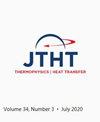Pulsating Heat Pipe Experiments for Microgravity Sounding Rocket Tests
IF 1.7
4区 工程技术
Q4 ENGINEERING, MECHANICAL
引用次数: 0
Abstract
Two flat plate diffusion-bonded pulsating heat pipes (PHPs) for the thermal management and heat dissipation of concentrated heat flux in electronics applications, such as aboard satellites and spacecraft, were specially developed for future tests aboard a sounding rocket in microgravity conditions. Both devices contain 26 channels with round cross sections, one with ultrasharp lateral grooves in the evaporator. Two heat sinks were tested: a water-cooling bath for the thermal characterization of the PHPs, and a copper box with a phase change material (dodecahydrate bibasic sodium phosphate) to be qualified as the heat storage for future microgravity tests. Water was used as the working fluid. The best filling ratio (relative to the total internal volume of the PHPs) was experimentally determined to be 50%, for which the devices presented the earliest startup and the lowest thermal resistance, around 0.033°C/W for the grooved PHP. This research proposes an efficient and alternative cooling method, the phase change material storage, to be used as a heat sink in future microgravity tests. Also, the microgravity effect on the thermal performance of such PHPs can be assessed by comparing the present results with future microgravity data obtained in an experimental module aboard a sounding rocket.微重力探空火箭试验脉动热管实验
两个平板扩散键合脉动热管(PHPs)用于电子应用(如卫星和航天器)中集中热流的热管理和散热,专门为将来在微重力条件下在探空火箭上进行试验而开发。这两种装置都包含26个圆形截面的通道,其中一个在蒸发器上有超尖锐的横向凹槽。测试了两个散热器:用于PHPs热表征的水冷浴,以及用于未来微重力测试的储热材料(十二水双碱磷酸钠)的铜盒。水被用作工作流体。实验确定最佳填充率(相对于PHPs的总内部体积)为50%,此时器件启动时间最早,热阻最低,槽状PHP的热阻约为0.033°C/W。本研究提出了一种高效的替代冷却方法,相变材料存储,将在未来的微重力测试中用作散热器。此外,通过将目前的结果与探空火箭上的实验舱获得的未来微重力数据进行比较,可以评估微重力对此类PHPs热性能的影响。
本文章由计算机程序翻译,如有差异,请以英文原文为准。
求助全文
约1分钟内获得全文
求助全文
来源期刊

Journal of Thermophysics and Heat Transfer
工程技术-工程:机械
CiteScore
3.50
自引率
19.00%
发文量
95
审稿时长
3 months
期刊介绍:
This Journal is devoted to the advancement of the science and technology of thermophysics and heat transfer through the dissemination of original research papers disclosing new technical knowledge and exploratory developments and applications based on new knowledge. The Journal publishes qualified papers that deal with the properties and mechanisms involved in thermal energy transfer and storage in gases, liquids, and solids or combinations thereof. These studies include aerothermodynamics; conductive, convective, radiative, and multiphase modes of heat transfer; micro- and nano-scale heat transfer; nonintrusive diagnostics; numerical and experimental techniques; plasma excitation and flow interactions; thermal systems; and thermophysical properties. Papers that review recent research developments in any of the prior topics are also solicited.
 求助内容:
求助内容: 应助结果提醒方式:
应助结果提醒方式:


